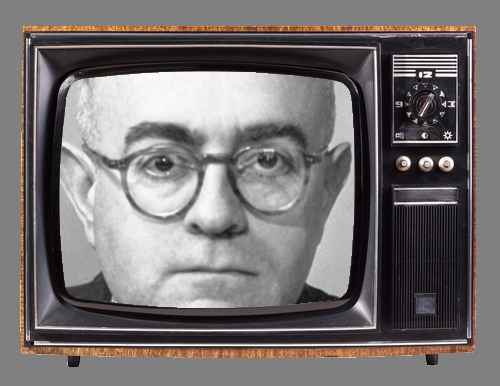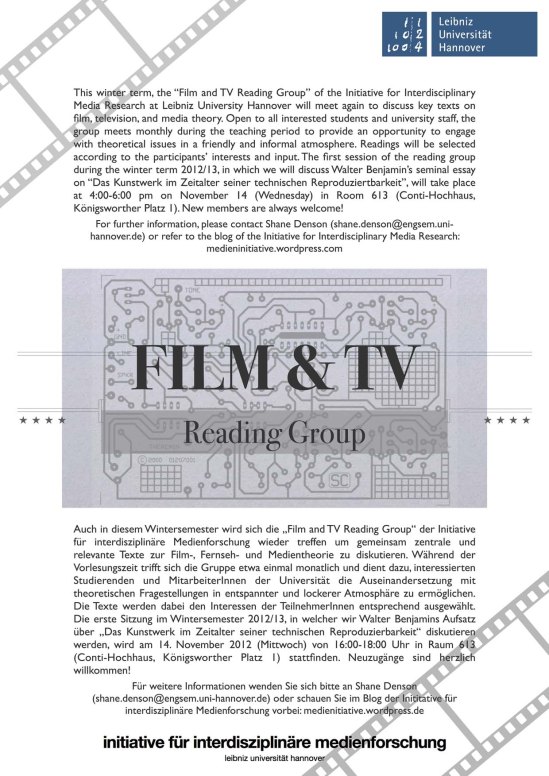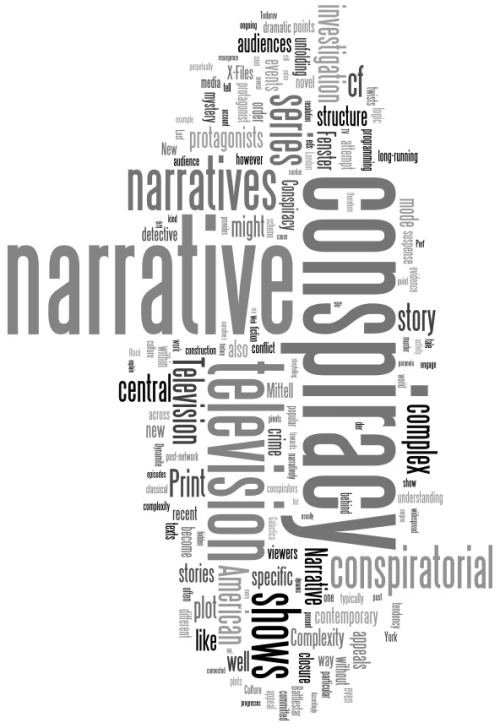On January 16, 2013, the Film & TV Reading Group will meet (at 4 pm in room 613, Conti-Hochhaus) to discuss “Prolog zum Fernsehen” [Prologue to TV] by Theodor W. Adorno (pp. 507 – 517 in Adorno’s Gesammelte Schriften, Band 10.2: Kulturkritik und Gesellschaft II — Eingriffe, Stichworte, Anhang). Felix Brinker will moderate the discussion. As always, all are welcome to join us! (Feel free to contact me for more info — email address can be found on the “About” page.)
Tag: TV
It’s Not Television (Or Is It?)
Three members of the Initiative for Interdisciplinary Media Research (Felix Brinker, Florian Groß, and Shane Denson) will be presenting papers at the upcoming conference “It’s Not Television” (22-23 February 2013, Goethe University of Frankfurt). Our abstracts can be found here:
Shane Denson: “Serial Bodies: Corporeal Engagement in Long-Form Serial Television”
Felix Brinker: “On the Politics of Long-Form Serial Storytelling and the Paranoid Eye of Active Audiences”
Abstract for Felix Brinker’s talk at the conference “It’s Not Television” (Frankfurt, 22-23 February 2013). See here for talks by other members of the Initiative for Interdisciplinary Media Research.
Narratively Complex Television Series and the Lure of Conspiracy – On the Politics of Long-Form Serial Storytelling and the Paranoid Eye of Active Audiences
Felix Brinker
The threat of conspiracy looms large in a striking number of recent American television series. From the efforts of 24’s and Homeland’s protagonists to stop terrorists, to the nefarious government conspiracies on Last Resort, Rubicon, and Prison Break, and the shadowy cabals plotting on Lost, Fringe, and Battlestar Galactica: television narratives about secret plots against the reigning order of things appear to be well suited to capture the imagination of contemporary audiences in the US and elsewhere. While the engagement with this theme lends itself to politicized readings, the motif of conspiracy is also part and parcel of a robust narrative structure that enables the unfolding of complex storylines. In this respect, ‘conspiracy’ denotes not just a thematic preoccupation but also an organizational logic that allows these shows to tell long-running stories about investigations, cover-ups, and mysteries whose resolutions are perpetually deferred. As detective stories of a grand scope, these shows keep viewers hooked by juggling the appeals of suspense and mystery, by countering each revelation with a plot twist tailored to sustain audience interest.
My paper will sketch the basic parameters of this mode of storytelling and discuss the audience practices it inspires. I argue that, in order to perform within the competitive media environment of the convergence age, said shows rely on the structure of conspiracy to encourage audiences to carefully comb through their narrative material in search of hidden clues about the plots’ mysteries. By doing so, they ask viewers to rely on an interpretive logic that parallels the paranoid hermeneutics of conspiracy theorists: analysis and interpretation of transmedial story-worlds can thus become a pleasurable, associative, and open-ended activity that allows the viewer to assert her authority over the (shifting) overall meanings of (the) (hi)story. The political significance of these shows therefore lies less in their overt content, but rather manifests itself on the level of storytelling strategies and the audience practices enabled by the latter.
Shane Denson: “Corporeal Engagement in Long-Form Serial Television”
Abstract for Shane Denson’s talk at the conference “It’s Not Television” (Frankfurt, 22-23 February 2013). See here for talks by other members of the Initiative for Interdisciplinary Media Research.
Serial Bodies: Corporeal Engagement in Long-Form Serial Television
Shane Denson
Discussions of so-called “Quality TV” and the narrative complexity seen to characterize the best of contemporary serial television productions often trade on categories of distinction derived from comparisons with “respectable” cultural forms (e.g. the novel as a model for “serious” engagement); these discourses value an intellectually demanding, heady sort of appeal that is opposed both to the narrative simplicity supposedly characteristic of older televisual forms (strictly episodic forms, melodramatic soap operas, etc.) and to the baser appeals of contemporary “trash TV” (e.g. the basically voyeuristic interest encouraged by reality TV). Interestingly, though, graphic scenes of sex and violence proliferate across contemporary television series, including shows widely valued for their cognitive demands; today, bodies are put on display, violated, tortured, dissected, and ripped apart in ways unimaginable on TV screens just a decade ago. In this presentation, I argue that these body spectacles – which range from clinical/forensic to brutal/gory to pornographic – challenge us to rethink the basis of television studies’ formal and normative distinctions. In particular, the complex mental operations valued as correlates of narratological complexity must be seen to take place side by side with a range of more corporeal responses on the part of television viewers. Finally, I propose an alternative view of televisual complexity and serialization: appealing to the body as much as the head, contemporary television will be shown to involve a serialization of bodies (both onscreen and off) that constitutes a central affective mechanism for engaging viewers week after week in long-form serial television.
Florian Groß: “The Creative Individual and Generic Family Structures in Recent TV Series”
Abstract for Florian Groß’s talk at the conference “It’s Not Television” (Frankfurt, 22-23 February 2013). See here for talks by other members of the Initiative for Interdisciplinary Media Research.
Born Alone, Die Alone, But Never Dine Alone:
The Creative Individual and Generic Family Structures in Recent TV SeriesFlorian Groß
Ever since television has been part of the American family, the American family has been part of television. Even under the “not TV”-paradigm, family remains a central aspect of television, as shows like The Sopranos or Six Feet Under attest. In many recent shows, this constitutive part of the televisual landscape interacts with a highly fetishized figure in contemporary television, the creative individual. Californication’s Hank Moody, Mad Men’s Don Draper, or 30 Rock’s Liz Lemon are but a few examples of non-conformist, iconoclast and ingenious characters who express their innate urges in various aesthetic(ized) fields and serially assert their individual freedom and self-reliance. Yet, despite their superficial undermining of traditional (family) concepts, they also take serial recourse to standard conceptions of family. They may be adulterers, divorcees, or singles, but they hardly ever define themselves without the (white, middle class, nuclear) family, which emerges as a structure that provides the creative heroes with boundaries that prevents them from becoming antisocial.
My paper analyzes this dynamic interaction between an aestheticized individualism and the continued relevance of family structures. Furthermore, I want to link this narrative aspect of television series to their respective take on genres. In an era that is purportedly moving beyond genre, it becomes nevertheless apparent that series frequently resort to classic televisual genres and thus return to their generic ‘family’. In the end, looking at recent television’s simultaneous deconstruction and reconstruction of the American family helps to explain how and why today’s segmented audience(s) are symbolically (re-)united by forms of television that restore the social function of an “electronic hearth” (Tichi).
Presidential Politics and the Anthropotechnical Interface
Watching election night coverage last night, I was struck by how commonplace a variety of presentation, visualization, and interfacing technologies have become in comparison to the last election four years ago, when many of these things were introduced and foregrounded — often somewhat awkwardly, as the videos here demonstrate. The shift has a great deal to do with much broader processes of habitualization through which touchscreen devices such as smartphones and tablet computers have been domesticated, de-exoticized, and rendered unspectacular in the intervening years. Taken for granted now as so much furniture of the lifeworld, it’s easy to lose sight of how fast these processes transpire, and of how differently things looked just a few years ago. In the interest, then, of cultivating a sort of media-archaeological awareness of the inherent transitionality and instability of our experiential and affective relations to the media-technical infrastructure of our lives, I’m posting here some glimpses from another world — several relevant video clips from the last presidential election night, along with some observations I originally posted the day after, on November 5, 2008:
America’s biggest media events, the Superbowl and the presidential election, are not simply mediated events but, centrally, events of mediation: showcases for new media technologies. This is a wonderful example. If I didn’t have a dissertation to write [update 2012: glad I’m done with that!], I’d be writing an article about CNN’s Virtual View (which is self-consciously placed “in the tradition of Princess Leia”). Watch them navigate between an ostensible story and a heightened awareness of the state-of-the-art special-effects. This is sci-fi, and not just because the “hologram” looks like something from Star Wars or because it seems to “beam” the correspondent in the style of Star Trek. This is sci-fi in a richer sense, because it perfectly utilizes the sci-fi film’s basic self-reflexive appeal to the technologies used to mediate its highly conventionalized story about technology.
Of course, the appearance of CNN’s holograph is not an isolated phenomenon. It partakes of a larger science-fiction context. The report of astronauts voting is a good example. Not only is outer space the traditional setting, the astronaut an established character, and the spaceship a central iconographic element in sci-fi; more importantly, the report provokes the question, as I asked last evening, how exactly did they cast their votes? With what kind of apparatus, via what channel of communication, and with what security measures in place? These are the same questions that one can ask about one’s local voting station: how do these new voting machines work, how do they communicate with one another, and are they trustworthy? The astronauts casting their votes are not interesting in themselves. Instead, they are an invitation to regard the apparently more mundane situation of earthbound voting from a technophilic, science-fiction perspective.
Meanwhile, the other networks foregrounded gigantic touchscreens, double ticker text lines, made-for-HDTV special features, and parallel online supplements in their bids to captivate viewers (see here for more). Since I couldn’t stay awake for it, I’ll be loading Obama’s victory speech (and maybe McCain’s concession of defeat while I’m at it) onto my iPod. Watching it there will in some way consummate the message of the medium, and I anticipate that it will also speak to a level at which consummation is eternally deferred: Now if I only had an iPhone or an iPod touch to match the tactile response, if not the scale, of those giant touchscreens [update 2012: the iPad had not been released yet…]. Isn’t that what this election was all about?
Film & TV Reading Group (Winter 2012/13)
(Click on the image for a larger view)
As indicated on the flyer above, the Film & TV Reading Group will have its first meeting of the semester on Wednesday, November 14 (4:00 pm in room 613, Conti-Hochaus), where we will discuss Walter Benjamin’s famous “Artwork” essay. The topics for the following meetings have not been determined yet, so if there is anything you would like to discuss, please let me know. Tentatively, the following dates have also been reserved: December 5 and January 16 (also 4:00 – 6:00 pm in room 613). New participants are always welcome!
Profanity TV / Digital Humanities: Independent Studies Final Presentation
On Tuesday, July 17 (6:00 pm, room 615 of the “Conti-Hochhaus” at Königsworther Platz 1), the participants in my independent studies course on “Digital Media and Humanities Research” will present their projects at an event that is open to all interested parties. Linda Kötteritzsch, Julia Schmedes, and Mandy Schwarze will discuss their blog, “Bonfire of the Televised Profanities,” and its significance at the intersection of TV studies and digital media, while Urthe Rehmstedt and Maren Sonnenberg will approach questions around the digital humanities through the medium of the video essay. Spread the word, and check it out if you can!
The Conspiratorial Mode of Storytelling in Contemporary American Television Series
My colleague and office-mate, Felix Brinker, has just published an exciting article on what he calls the “conspiratorial mode” of storytelling in recent American TV series. This was part of a larger project — Felix’s MA thesis — so perhaps we can expect to see other aspects in the future (maybe also in connection with his PhD?). In the meantime, here is the abstract for the article, which appears in Aspeers 5 (2012): 87-109:
Hidden Agendas, Endless Investigations, and the Dynamics of Complexity: The Conspiratorial Mode of Storytelling in Contemporary American Television Series
Felix Brinker
Contemporary American television shows such as Lost, Battlestar Galactica, 24, Alias, or Fringe construct long-running story-arcs around central narrative enigmas in order to inspire committed and regular viewing. In the unfolding of their central storylines such shows perpetually resist closure and defer the resolution of their central conflicts. The specific narrative trajectory of these shows, this paper argues, is best understood if viewed through the lens of conspiracy theory – or, rather, if these shows are conceptualized as conspiracy narratives: as crime fictions of a grand (and, at times, cosmic) scope, as stories that circle around a potentially endless conflict between cunning protagonists and nefarious hidden powers, between investigations and cover-ups. In such programs conspiracy is more than just a thematic preoccupation — it also functions as an organizational logic or structure that governs the way in which these shows tell their stories.
I argue that the success of such programs is indebted to this particular way of storytelling, which I call the ‘conspiratorial mode.’ This article sketches the narrative structure of conspiratorial programs, situates them in the context of post-network television, and considers their curious dynamics of narrative progression and deferral. Finally, it offers an account of the shared characteristics of shows that partake in the conspiratorial mode of storytelling and suggests reasons for the recent prominence of conspiracy narratives in American television beyond and apart from a paranoia that is supposedly widespread in contemporary American culture.
The full text of the article can be found here.
Quality TV (Prezi @ Profanity TV)
Recently, I asked the participants in the independent studies course on “Digital Media and Humanities Research” to experiment a bit with presentation software, including the freely available Prezi — which the students running the “Profanity TV” blog did with very impressive results: here is their elaborate presentation on Quality TV. (And in case you missed it, make sure you check out their introductory “trailer” video for the site, which explains what the blog, i.e. their project for the course, is all about.)








